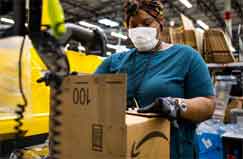As we’ve reported many times, Amazon has been under extreme scrutiny and criticism over worker safety at its fulfillment centers, often focused on the role of what critics say is a key factor – Amazon’s alleged tough standards for employee productivity and resulting measurement.
Supply Chain Digest Says... |
|
|
Amazon has consistently challenged various studies unfavorable to it on the matter,saying the comparisons to other distribution companies were not valid, that the study methodologies we not up to snuff or other criticisms.
Still, Amazon has recently touted the reduction in FC injuries as a result of various new deployments of warehouse robots.
The latest skirmish: the majority staff for the Senate Committee on Health, Education, Labor and Pensions, led by Senator Bernie Sanders, found that Amazon ignored internal recommendations that the company scale back productivity standards for FC worker to curb injuries, in a report released just before Christmas.
Instead, Amazon accepted “injuries to its workers as the cost of doing business,” according to the report, among other findings.
To produce the 159-page report, Senate committee staffers interviewed 135 workers and reviewed 1,400 documents provided by workers. Amazon contributed 285 documents
In a blog post, Amazon vigorously disputed the report’s critique, stating that it is “wrong on the facts and features selective, outdated information that lacks context and isn’t grounded in reality.”
The whole issue is a bit confusing, as Amazon started one internal review of its labor practices, only to launch a second study group after internal criticism of the first group’s approach.
According to the Transport Topics web site, the initial Project Soteria was launch in 2020 and was said be the first time Amazon had conducted a comprehensive analysis of the causes of injuries in its FCs.
The study did in fact find a link between worker speed in doing their tasks and injuries, echoing a similar finding made by Washington state workplace regulators.
The report and recommended pausing speed-related disciplinary measures and adding more downtime to workers’ schedules.
But then, two years into the company’s investigation, Amazon’s senior safety executive asked another team to review the Soteria team’s work. The review - called Project Elderwand - was critical of Soteria’s methodology and instead recommended increasing the frequency of safety meetings.
(See More Below)
|
CATEGORY SPONSOR: SOFTEON |
|
|
| |
|
|
 That even though that second internal study found that the workers who grab items from Amazon’s robotic storage units increased the likelihood of back injuries alongside the number of items picked during a shift. That even though that second internal study found that the workers who grab items from Amazon’s robotic storage units increased the likelihood of back injuries alongside the number of items picked during a shift.
Looking into this matter, the new Senate report says that “There is a clear through line in the evidence: Even when Amazon was presented with an analysis generated by its own internal teams concluding that higher speed can increase the risk of injuries, it chose to ignore that analysis and instead to search for alternative explanations that were more convenient and that favored the company’s bottom line.”
Amazon now says that Soteria’s analysis was preliminary, outdated and inaccurate. A company spokesperson also noted that the Washington state Bureau of Industrial Appeals earlier this year dismissed high-profile workplace safety citations against the company. The state labor regulator is appealing that ruling.
Do you have any comments on this Amazon labor story? Let us know your thoughts at the Feedback button below (email) or in the Feedback section.
|